|
June 24, 2020
Dear Neighbors and Friends:
I hope that you and your loved ones are doing well, staying healthy, and looking out for your neighbors and friends.
Along with today’s numbers (which include three deaths, sadly), you’ll find a synopsis of the newly released OHA COVID Weekly Report, as well as a rundown of the first day of the Legislature’s special session.
Speaking of the latter, many of you are writing me with input on the bills that are up for debate and decision. I appreciate your engagement, which is particularly helpful for me right now. Please keep them coming!
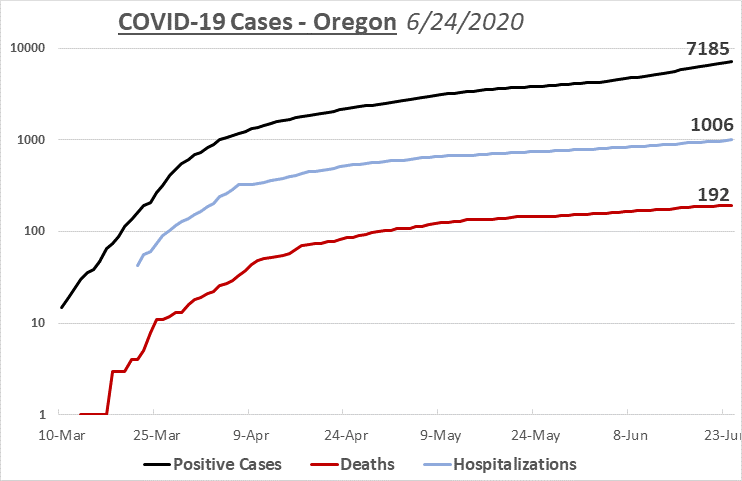
TODAY’S CORONAVIRUS AND CORONAVIRUS RESPONSE UPDATE
-
Positive Cases: OHA reports today that 167 additional Oregonians have tested positive. The cumulative total for those testing positive is now 7,185.
-
Total Tests happy: The cumulative total number tests in Oregon now stands at 213,749. That’s an increase of 3,293 tests.
-
Ratio: The percentage of positive results for today is 5.1%. The national percentage is 7.7%. See below for a graph showing Oregon’s daily percentage changes over the last 14 days.
-
Deaths: I’m afraid that I have to report 3 additional deaths due to the coronavirus reported today. The total number of deaths in Oregon is now 195.
-
Hospitalized: OHA reported 23 new COVID hospitalizations today. The cumulative total of those who’ve been hospitalized for COVID-19 is now 1,006.
-
Presumptive Cases: OHA is now including “presumptive COVID-19 cases” in its daily reports, consistent with recently amended guidance from the Centers for Disease Control and Prevention. A presumptive case is someone who does not yet have a positive PCR test result but is showing symptoms and has had close contact with a confirmed case. If they later test positive by PCR, those will be recategorized as confirmed cases. OHA reports 4 additional presumptive positives today. The total number of presumptive cases is 259.
-
Other Hospital Information:
- Patients Currently w COVID-19 Symptoms (who may or may not have received a positive test result yet): 185 (1 more than yesterday). Of those, 89 have already received a positive test back.
- Available ICU Beds: 147 (same as yesterday).
- Other Available Beds: 764 (84 fewer than yesterday).
- ICU Patients w COVID-19 Symptoms: 59 (1 more than yesterday).
- COVID-19 Patients Currently on Ventilators: 29 (1 more than yesterday).
- Available Ventilators: 778 (4 fewer than yesterday).
-
Dashboards
-
Today’s National Numbers:
-
PPE:
-
Additional Brief Updates:
- We just received a request from Oregon’s colleges and universities to get the word out to current DACA students that in the wake of the recent Supreme Court decision rejecting the Trump Administration’s decision to end DACA, it’s likely that there will be another attempt by the Administration to end the program. Current DACA students should consider renewing their DACA applications ASAP. For more information on how to do that, they can contact their colleges and universities. Here is a list of the contact people at each of Oregon's public colleges and universities.
-
DEQ reported in a release today that vehicle inspections will resume in Gresham and Northeast Portland on June 30. The Medford-Ashland, Clackamas, Hillsboro/Sunset, Sherwood and Scappoose stations reopened last week. Not surprisingly, they’ve been experiencing long lines, and it’s expected that the same will be true in Multnomah County. The moratorium on citations for vehicles with expired tags does continue until October 1.
Special Session Day One
The session began this morning with adoption of session rules and introduction of bills. Nine senate bills were introduced, along with 25 house bills. Senators were all on the floor together, and nearly all of us were wearing face coverings. The unfortunate exceptions were Brian Boquist and Dennis Linthicum, despite the fact that starting today face coverings are legally required in Marion County in indoor public spaces like the Capitol and those not wearing face coverings are putting everyone else in jeopardy. All the other Republican senators were wearing face coverings.
Though we were trying to keep our actual speaking time to a minimum, a few senators took the opportunity to recognize two House members who have died since we last met: Democrat Mitch Greenlick and Republican Vic Gilliam. That was a nice touch. Both men passed away after long illnesses. They were two of my favorites, and I know I wasn’t alone.
Some partisan disagreements were evident in the morning session, however. The session rules were adopted, but on a straight party-line vote. Republican leader Fred Girod expressed their objection for two reasons: as is normal for a special session, all bill introductions and amendments need to come through the presiding officers (Speaker of the House and Senate President), who are both Democrats; and the fact that the public was not allowed into the Capitol to observe and interact with legislators. I’ve already mentioned in previous newsletters that the latter decision was made in order to keep legislators and staff safe.
The Joint Special Session Committee met for several hours in the morning and afternoon in order to take public testimony on bills, discuss them, and pass them on to the House or Senate floor. The committee met in person to vote, but the public hearings, which took up the bulk of the time, were all done remotely, with legislators in their offices. The following bills made it out of committee (which means that they will almost certainly pass on the floors of the two chambers) either as originally introduced or in amended form:
SB 1602: Requires Governor to facilitate mediation sessions between forest industry and environmental interest representatives.
SB 1607: Extends for one year small school district grants and school district funding for foreign exchange students.
SB 1603: Modifies definitions applicable for purposes of universal service surcharge and creates fund for broadband.
HB 4210: Repeals driving privilege suspension and eliminates imposition of driving privilege restrictions for failure to pay fine.
HB 4202: Makes technical adjustments to the corporate activity tax.
HB 4209: Allows Eastern Oregon Border Economic Development Board to enter into agreement with third-party administrator to operate programs for awarding grants and making loans that enhance and expand workforce development and economic development in Eastern Oregon Border Economic Development Region.
HB 4211: A technical fix that clarifies timing of when the Department of Education is required to make transfers from Fund for Student Success.
HB 4206: Authorizes State Department of Agriculture to adopt rules establishing program of state inspection for processing and sale of meat products from amenable species, including but not limited to cattle and sheep. An amendment specifically excludes horses and other equines from being processed for meat.
You can follow the links to see the actual bill language, any amendments, and the vote counts. Two passed on party-line votes (the broadband and drivers license bills), while the others were bipartisan. HB 4213, the bill prohibiting residential and commercial evictions during the emergency period, received a lot of testimony and debate, but not an actual vote by the committee. Amendments that appear likely to win majority support for the bill are being drafted tonight, and the bill will be taken up for final action on Thursday.
The Committee resumes its work on Thursday morning at 10:00, with 14 bills on the agenda. They include all of the police accountability bills, so we expect a lot of public testimony. You can see the agenda, instructions for testimony, meeting materials, and a link to watch the hearing here.
I again want to express my appreciation for the steps that were taken to be mindful of the health and safety of legislators and staff alike, while providing extensive opportunity for public testimony from people from all over the state who were able to address and interact with legislators on a variety of topics. Yes, there were the occasional problems with phone lines and mute buttons, but the level of engagement (and patience) was happily very high.
More to come tomorrow.
Latest OHA Weekly Report Released
This week's report was released this afternoon. It shows that for the fourth week in a row, newly reported COVID-19 cases increased over the previous week. During the week of June 15-21, OHA recorded 1,263 new cases of COVID-19 infection, a 40-percent increase from the previous week's total of 898 new cases. The percentage of positive test results was 3.7% for the week, up from 3.1% the previous week.
Interestingly (and fortunately), while we’re seeing an increase in reported cases, we’re not seeing an increase in severity. Twelve Oregonians were reported to have died last week, compared with 16 deaths in the preceding week. Hospitalizations and deaths remain well below their peaks, even though reported cases have been increasing for four weeks, and the percentage of emergency department visits attributable to COVID-19-like symptoms remains below 1 percent. Even though hospitalizations are increasing, for now they appear to be well within our medical system’s ability to handle them.
The report again demonstrates, however, significant disparities among racial groups. You can see this in the charts below, with data that I’ve taken from the June 17 report and from this report. It allows you to see at a glance the proportion of case counts within different racial groups and ethnic groups (technically, “Hispanic” is not a race and is counted as an ethnic group, with numbers from a separate chart).
You’ll see again how much higher the rates per 10,000 are for most racial/ethnic groups compared to White Oregonians, and you’ll see that the spread is increasing. You’ll also see, interestingly, that the percentage of those hospitalized and dying from the disease are lower for non-Whites than for the population of White Oregonians.
This may be a function of age: many of those contracting the virus via workplace outbreaks are from BIPOC (Black, Indigenous, People of Color) populations. These frontline workers tend to be younger and thus somewhat less likely to experience severe consequences from the disease. Unfortunately, the report doesn’t get into that level of detail.


The report again provides information about signs, symptoms, and risk factors; racial/ethnic/age/gender demographics; recovery; outbreaks in long-term care; workplace outbreaks; hospital rates; and the breakdown of cases by zip code.
This week’s report shows 15 outbreaks in long-term care facilities that are still considered active. They are responsible for 260 cases and 13 deaths. In addition, there are 34 outbreaks considered resolved. They are responsible for 561 cases and 99 deaths. The total for active and resolved facilities is thus 821 cases and 112 deaths. (The facilities listed include all where there was at least one death and at least three cases, so there are additional cases out there that are not included.)
The listing of long-term care facilities now includes both those considered “active” and those considered “resolved.” It’s easier now to get a sense of the total cases and deaths that involve residents and staff of long-term care facilities. That’s a good improvement. I’m still hoping to see separate listings for workers added in the future.
Similarly, there are separate listings for workplace outbreaks that are “active” and “resolved,” but without deaths identified by workplace. So far, eight deaths have been the result of workplace outbreaks. Twenty-eight workplaces are on the “active” list, and 24 of those listed are resolved.
Here’s what OHA has to say about these workplace outbreaks:
The presence of correctional facilities and food packing and agricultural worksites on this list highlights the challenges of controlling COVID-19 in settings where people must work or live in close proximity. In addition, people of color are overrepresented in agricultural and correctional settings, perhaps contributing to higher rates of COVID-19 observed in these groups. OHA publishes these data in response to public request, but with some concern that workers or staff members at these workplaces might be subject to discrimination. State and local public health officials work intensively with staff at workplaces where outbreaks are identified to isolate sick workers, test and quarantine those who have been exposed and implement workplace changes to reduce risk of transmission. Unless otherwise noted, public health officials have determined that these workplaces, their employees and their products do not pose significant risk to the public. Employees of a business with a workplace outbreak should never be subjected to discrimination or excluded from patronizing other businesses. In fact, discriminating against employees or avoiding products might jeopardize the economic viability of essential local businesses.
You’ll see that the zip code list again reveals the various hot spots around the state, presented in terms of cases per 10K residents. They should come as no surprise: 97850 (LaGrande, site of the big outbreak at the Pentecostal church), 97026 (agricultural Marion County), and 97761 (Warm Springs in Jefferson County). Here is a zip code locator for you to use as you look at the zip code numbers.
Where Are Today’s New Cases?
If we put together the positive test results and new “presumptive” cases reported today, the overall number of new cases is 171. Here is the breakdown by county for today:
The new cases reported today are in the following counties: Benton (2), Clackamas (8), Clatsop (1), Deschutes (4), Jackson (2), Jefferson (3), Klamath (3), Lincoln (9), Linn (1), Malheur (5), Marion (13), Multnomah (45), Polk (1), Umatilla (35
Note: One case previously reported in Hood River County was determined not to be a case; the county case count has been appropriately adjusted.
Benton (2)
Clackamas (8)
Clatsop (1)
Deschutes (4)
Jackson (2)
Jefferson (3)
Klamath (3)
Lincoln (9)
Linn (1)
Malheur (5)
Marion (13)
Multnomah (45)
Polk (1)
Umatilla (35)
Union (5)
Wasco (2)
Washington (31)
Yamhill (1)
And the Deaths:
Oregon’s 193rd COVID-19 death is a 63-year-old man in Lincoln County who tested positive on June 11 and died on June 23, at Samaritan Pacific Community Hospital. He did not have underlying medical conditions.
Oregon’s 194th COVID-19 death is 78-year-old man in Clackamas County who tested positive on June 16 and died on June 22, his place of death is being confirmed. He had underlying medical conditions.
Oregon’s 195th COVID-19 death is an 87-year-old woman in Marion County who tested positive on June 17 and died on June 23, at Legacy Meridian Park Medical Center. She had underlying conditions.
Additional Graphs:

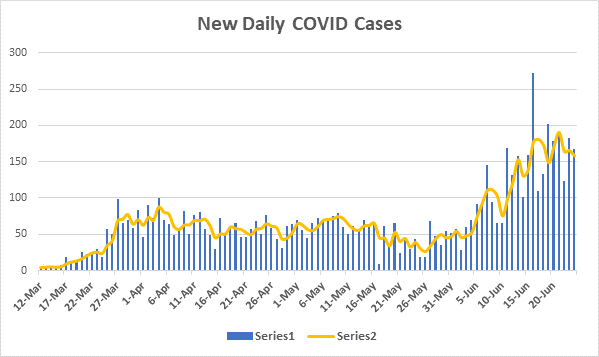

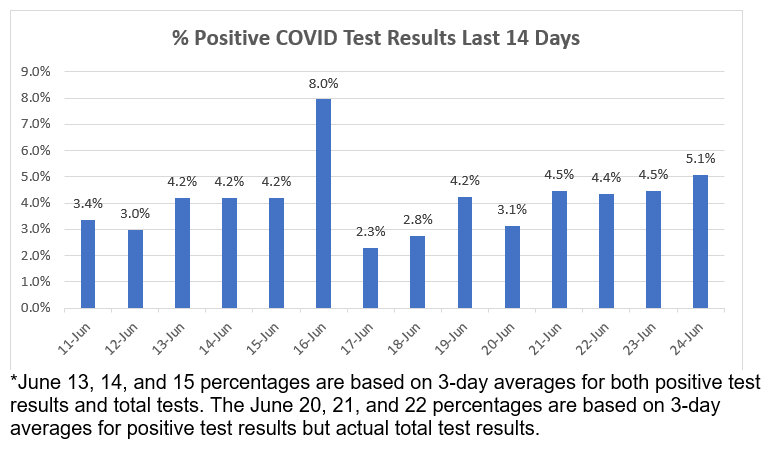
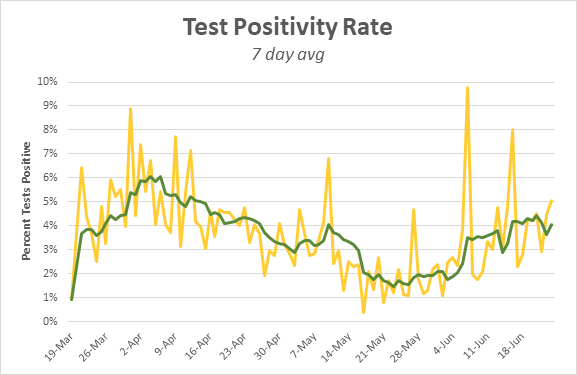
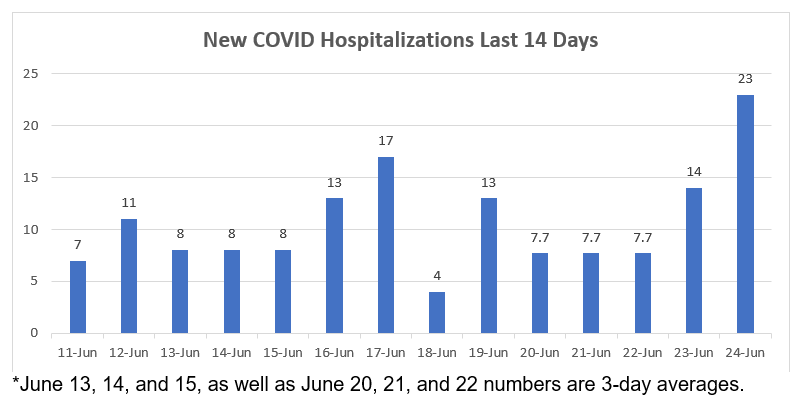
Want to See Past Newsletters?
If there was COVID-related information in a past newsletter that you want to go back to, but find you’ve deleted it, you can always go to my legislative website (www.senatordembrow.com), click on “News and Information,” and you’ll find them all there. Also, if someone forwarded you this newsletter and you’d like to get it directly, you can sign up for it there.
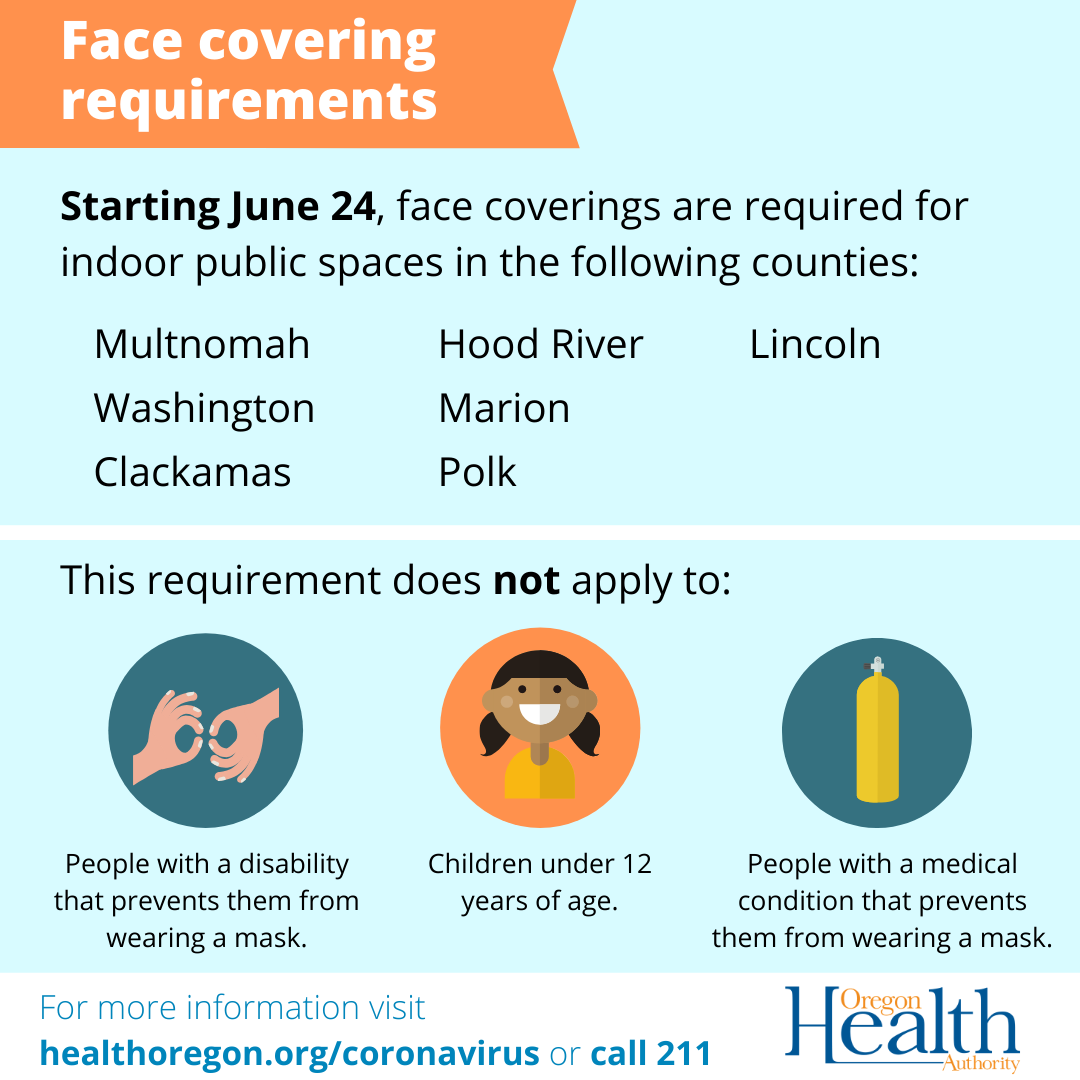
AND FINALLY,
Here again are some resources that you will find useful:
If the above links are not providing you with answers to your questions or directing you to the help that you need, please consider me and my office to be a resource. We’ll do our best to assist you or steer you in the right direction.
Best,
 Senator Michael Dembrow
District 23
email: Sen.MichaelDembrow@oregonlegislature.gov
web: www.senatordembrow.com
phone: 503-986-1723
mail: 900 Court St NE, S-407, Salem, OR, 97301
|